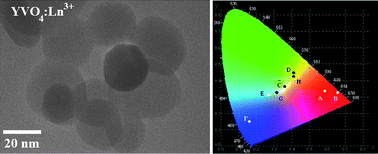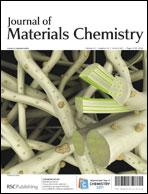Lanthanide ions (Ln3+ = Eu3+, Dy3+, Tm3+) doped YVO4 and silica coated YVO4:Ln3+ (YVO4:Ln3+@SiO2) nanoparticles have been prepared by a microemulsion route using Cetyl trimethyl ammonium bromide (CTAB)/n-butanol/hexane/water. Average crystallite sizes of YVO4:Ln3+ annealed at 500 and 900 °C are found to be ∼30 and ∼80 nm, respectively. Successful coating of the silica on the YVO4:Ln3+ core could be observed by transmission electron microscopy. The silanol group (SiO–H) is present in silica coated samples (heated up to 500 °C) and acts as luminescence quencher. The luminescence intensity and lifetime of those samples were less than those of their counterpart core samples. This has been attributed to the multi-phonon relaxation arising from high vibrational energy of the silanol group (3750 cm−1). When annealed up to 900 °C, both the luminescence intensity and the lifetime for silica coated systems increase significantly due to the loss of the silanol group, as well as the extent of reduction of surface non-radiative process at the core-shell formation. In case of triple doping (Ln3+ = Eu3+, Dy3+ and Tm3+), the emission of Dy3+ is more than that of either Eu3+ or Tm3+. This has been related to the energy transfer from Dy3+ to Eu3+ or Tm3+. Interestingly, a significant difference in the asymmetric ratio of electric dipole allowed transition to magnetic dipole allowed transition was observed when different Ln3+ ions are doped in the same host. This observation has been explained on the basis of their full width at half maximum of the emission peak. Based on the Commission Internationale d'Eclairage (CIE) coordinates calculations, only Dy3+ and triple Ln3+ doped YVO4 samples have CIE coordinates close to the ideal white light values amongst the samples. These materials could be used as potential nanophosphors for white light-emitting diodes (LEDs) applications.

You have access to this article
 Please wait while we load your content...
Something went wrong. Try again?
Please wait while we load your content...
Something went wrong. Try again?


 Please wait while we load your content...
Please wait while we load your content...